On This Page:
- Background
- Measure
- Healthy People 2030 Target
- Data Source
- Trends and Most Recent Estimates
- Related Cancers
- Additional Information
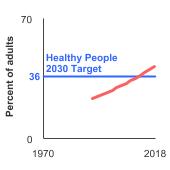
Background
Consistent evidence indicates that preventing excess body weight and obesity reduces the risk of several types of cancer, including colorectal, breast (among women who have gone through menopause), uterine, esophageal, renal cell (kidney), liver, and pancreatic cancers.
Research has also identified an association between obesity and worse prognosis and outcomes among some cancer patients, particularly those with breast, prostate, liver, or colon cancer. Excess body weight is thought to contribute to as many as one in five cancer-related deaths in the United States.
Among children, obesity is linked to a higher risk for obesity, metabolic diseases, and other chronic diseases and conditions later in adulthood, including cancer risk.
While there is still much to be learned about the link between excess weight and cancer, people with overweight or obesity are encouraged to lose weight and maintain a healthy lifestyle. Doing so has the potential to reduce both cancer- and non-cancer-related morbidity.
Measure
Adults: The percentage of adults aged 20 years and older with a healthy weight, overweight, or obesity. These weight groups are defined by BMI, which is calculated by dividing weight in kilograms by height in meters squared. For most adults, experts consider a BMI within the range of 18.5 to 24.9 as healthy weight, a BMI between 25 and 29.9 as overweight, and a BMI of 30 and above as having obesity.
Children and adolescents: The percentage of children and adolescents aged 2-19 years with a healthy weight, overweight, or obesity. These weight groups are defined by a measurement called the body mass index (BMI) z-score, which is calculated based on BMI sex- and age-specific percentiles (from the CDC Growth Charts). For most children, experts consider BMI-for-age percentiles between 5-84% as healthy weight, between 85-94% as overweight, and 95% or above as having obesity.
Data Source
Centers for Disease Control and Prevention, National Center for Health Statistics, National Health and Nutrition Examination Survey (NHANES).
The NHANES 2017-2018 data point for the adult weight estimates were replaced with the NHANES 2017-March 2020 Pre-pandemic data point. More information is available at NHANES Questionnaires, Datasets, and Related Documentation.
Healthy People 2030 Target
- Reduce the proportion of children and adolescents with obesity to 15.5 percent.
- Reduce the proportion of adults with obesity to 36.0 percent.
Healthy People 2030 is a set of goals set forth by the Department of Health and Human Services.
Note: Goals are indicated as blue line on Detailed Trend Graphs.
Trends and Most Recent Estimates
- Body Weight Comparison
Children and Adolescents
Percentage of children and adolescents aged 2-19 years with a healthy weight, overweight, or obesity, 1988-2023 Overview Graph Detailed Trend Graphs Most Recent Estimates (2021 to 2023) Percent of children and adolescents 95% Confidence Interval 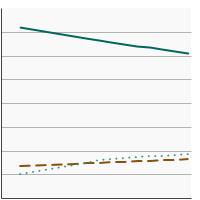

Healthy Weight 
59.9 57.3 - 62.4 Overweight 
15.0 12.9 - 17.1 Obese 
21.0 18.6 - 23.3 The 2021 to 2023 data point is from the NHANES August 2021-August 2023 data cycle. Adults
Percentage of adults aged 20 years and older with a healthy weight, overweight, or obesity, 1971-2023 Overview Graph Detailed Trend Graphs Most Recent Estimates (2021 to 2023) Percent of adults 95% Confidence Interval 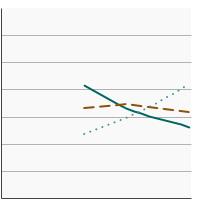

Healthy Weight 
26.3 23.0 - 29.6 Overweight 
31.9 30.0 - 33.8 Obese 
40.2 36.2 - 44.1 The 2021 to 2023 data point is from the NHANES August 2021-August 2023 data cycle.
- Children and Adolescents, Healthy Weight
By Sex
Percentage of children and adolescents aged 2-19 years at a healthy weight by sex, 1988-2023 Overview Graph Detailed Trend Graphs Most Recent Estimates (2021 to 2023) Percent of children and adolescents 95% Confidence Interval 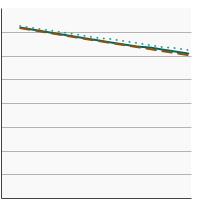

Both Sexes 
59.9 57.3 - 62.4 Male 
59.3 56.1 - 62.4 Female 
60.5 56.6 - 64.4 The 2021 to 2023 data point is from the NHANES August 2021-August 2023 data cycle. By Race/Ethnicity
Percentage of children and adolescents aged 2-19 years at a healthy weight by race/ethnicity, 1988-2023 Overview Graph Detailed Trend Graphs Most Recent Estimates (2021 to 2023) Percent of children and adolescents 95% Confidence Interval 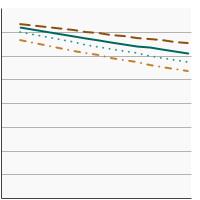

All Races/Ethnicities 
59.9 57.3 - 62.4 Non-Hispanic White 
63.2 59.4 - 67.0 Non-Hispanic Black 
52.0 43.2 - 60.8 Hispanic 
53.7 48.0 - 59.5 The 2021 to 2023 data point is from the NHANES August 2021-August 2023 data cycle. By Poverty Income Level
Percentage of children and adolescents aged 2-19 years at a healthy weight by poverty status, 1988-2023 Overview Graph Detailed Trend Graphs Most Recent Estimates (2021 to 2023) Percent of children and adolescents 95% Confidence Interval 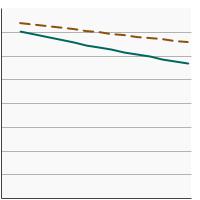

< 200% of the federal poverty level 
55.3 52.0 - 58.5 >= 200% of the federal poverty level 
62.9 59.6 - 66.2 The 2021 to 2023 data point is from the NHANES August 2021-August 2023 data cycle.
- Children and Adolescents, Overweight
By Sex
Percentage of children and adolescents aged 2-19 years who were overweight by sex, 1988-2023 Overview Graph Detailed Trend Graphs Most Recent Estimates (2021 to 2023) Percent of children and adolescents 95% Confidence Interval 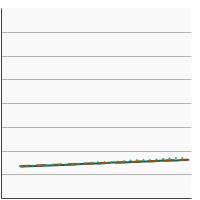

Both Sexes 
15.0 12.9 - 17.1 Male 
13.0 11.1 - 14.9 Female 
17.1 14.0 - 20.3 The 2021 to 2023 data point is from the NHANES August 2021-August 2023 data cycle. By Race/Ethnicity
Percentage of children and adolescents aged 2-19 years who were overweight by race/ethnicity, 1988-2023 Overview Graph Detailed Trend Graphs Most Recent Estimates (2021 to 2023) Percent of children and adolescents 95% Confidence Interval 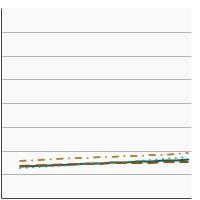

All Races/Ethnicities 
15.0 12.9 - 17.1 Non-Hispanic White 
14.3 12.3 - 16.4 Non-Hispanic Black 
11.4 6.9 - 16.0 Hispanic 
17.7 13.7 - 21.7 The 2021 to 2023 data point is from the NHANES August 2021-August 2023 data cycle. By Poverty Income Level
Percentage of children and adolescents aged 2-19 years who were overweight by poverty status, 1988-2023 Overview Graph Detailed Trend Graphs Most Recent Estimates (2021 to 2023) Percent of children and adolescents 95% Confidence Interval 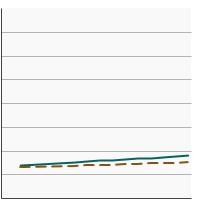

< 200% of the federal poverty level 
16.1 13.1 - 19.1 >= 200% of the federal poverty level 
13.7 11.6 - 15.9 The 2021 to 2023 data point is from the NHANES August 2021-August 2023 data cycle.
- Children and Adolescents, Obesity
By Sex
Percentage of children and adolescents aged 2-19 years with obesity by sex, 1988-2023 Overview Graph Detailed Trend Graphs Most Recent Estimates (2021 to 2023) Percent of children and adolescents 95% Confidence Interval 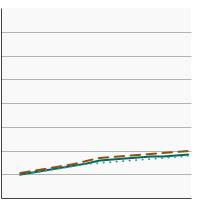

Both Sexes 
21.0 18.6 - 23.3 Male 
22.8 19.7 - 25.8 Female 
19.0 15.9 - 22.1 The 2021 to 2023 data point is from the NHANES August 2021-August 2023 data cycle. By Race/Ethnicity
Percentage of children and adolescents aged 2-19 years with obesity by race/ethnicity, 1988-2023 Overview Graph Detailed Trend Graphs Most Recent Estimates (2021 to 2023) Percent of children and adolescents 95% Confidence Interval 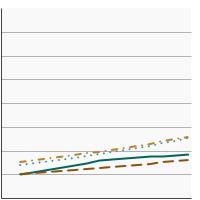

All Races/Ethnicities 
21.0 18.6 - 23.3 Non-Hispanic White 
17.2 14.9 - 19.5 Non-Hispanic Black 
33.9 23.7 - 44.1 Hispanic 
26.7 21.3 - 32.1 The 2021 to 2023 data point is from the NHANES August 2021-August 2023 data cycle. By Poverty Income Level
Percentage of children and adolescents aged 2-19 years with obesity by poverty status, 1988-2023 Overview Graph Detailed Trend Graphs Most Recent Estimates (2021 to 2023) Percent of children and adolescents 95% Confidence Interval 

< 200% of the federal poverty level 
25.6 22.7 - 28.5 >= 200% of the federal poverty level 
17.6 14.2 - 21.0 The 2021 to 2023 data point is from the NHANES August 2021-August 2023 data cycle.
- Adults, Healthy Weight
By Sex
Percentage of adults aged 20 years and older at a healthy weight by sex, 1971-2023 Overview Graph Detailed Trend Graphs Most Recent Estimates (2021 to 2023) Percent of adults 95% Confidence Interval 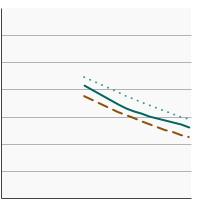

Both Sexes 
26.3 23.0 - 29.6 Male 
24.1 20.5 - 27.6 Female 
28.5 24.7 - 32.4 The 2021 to 2023 data point is from the NHANES August 2021-August 2023 data cycle. By Race/Ethnicity
Percentage of adults aged 20 years and older at a healthy weight by race/ethnicity, 1971-2023 Overview Graph Detailed Trend Graphs Most Recent Estimates (2021 to 2023) Percent of adults 95% Confidence Interval 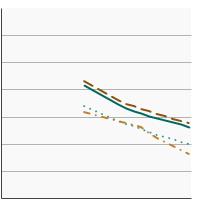

All Races/Ethnicities 
26.3 23.0 - 29.6 Non-Hispanic White 
27.0 24.3 - 29.7 Non-Hispanic Black 
19.5 16.4 - 22.6 Hispanic 
21.1 15.6 - 26.6 The 2021 to 2023 data point is from the NHANES August 2021-August 2023 data cycle. By Poverty Income Level
Percentage of adults aged 20 years and older at a healthy weight by poverty status, 1971-2023 Overview Graph Detailed Trend Graphs Most Recent Estimates (2021 to 2023) Percent of adults 95% Confidence Interval 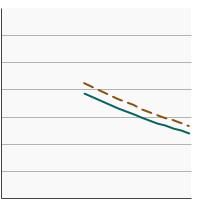

< 200% of the federal poverty level 
25.6 22.7 - 28.5 >= 200% of the federal poverty level 
26.2 22.3 - 30.1 The 2021 to 2023 data point is from the NHANES August 2021-August 2023 data cycle. By Education Level
Percentage of adults aged 25 years and older at a healthy weight by highest level of education obtained, 1971-2023 Overview Graph Detailed Trend Graphs Most Recent Estimates (2021 to 2023) Percent of adults 95% Confidence Interval 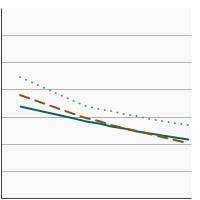

Less than High School 
26.1 20.0 - 32.2 High School 
20.3 15.3 - 25.3 Greater than High School 
26.3 23.2 - 29.4
- Adults, Overweight
By Sex
Percentage of adults aged 20 years and older who were overweight by sex, 1971-2023 Overview Graph Detailed Trend Graphs Most Recent Estimates (2021 to 2023) Percent of adults 95% Confidence Interval 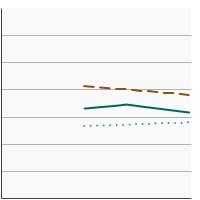

Both Sexes 
31.9 30.0 - 33.8 Male 
35.6 32.6 - 38.5 Female 
28.3 26.3 - 30.3 The 2021 to 2023 data point is from the NHANES August 2021-August 2023 data cycle. By Race/Ethnicity
Percentage of adults aged 20 years and older who were overweight by race/ethnicity, 1971-2023 Overview Graph Detailed Trend Graphs Most Recent Estimates (2021 to 2023) Percent of adults 95% Confidence Interval 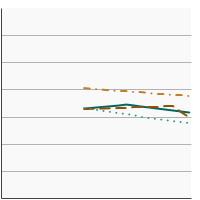

All Races/Ethnicities 
31.9 30.0 - 33.8 Non-Hispanic White 
32.1 29.8 - 34.4 Non-Hispanic Black 
28.3 23.7 - 32.9 Hispanic 
34.1 30.9 - 37.3 The 2021 to 2023 data point is from the NHANES August 2021-August 2023 data cycle. By Poverty Income Level
Percentage of adults aged 20 years and older who were overweight by poverty status, 1971-2023 Overview Graph Detailed Trend Graphs Most Recent Estimates (2021 to 2023) Percent of adults 95% Confidence Interval 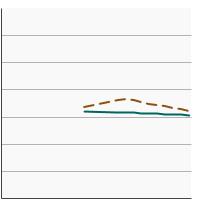

< 200% of the federal poverty level 
28.5 26.2 - 30.7 >= 200% of the federal poverty level 
34.2 31.7 - 36.7 The 2021 to 2023 data point is from the NHANES August 2021-August 2023 data cycle. By Education Level
Percentage of adults aged 25 years and older who were overweight by highest level of education obtained, 1971-2023 Overview Graph Detailed Trend Graphs Most Recent Estimates (2021 to 2023) Percent of adults 95% Confidence Interval 

Less than High School 
28.4 23.2 - 33.7 High School 
30.5 27.3 - 33.7 Greater than High School 
33.3 30.6 - 36.0
- Adults, Obesity
By Sex
Percentage of adults aged 20 years and older with obesity by sex, 1971-2023 Overview Graph Detailed Trend Graphs Most Recent Estimates (2021 to 2023) Percent of adults 95% Confidence Interval 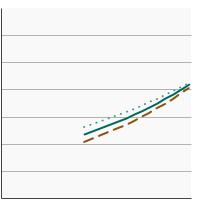

Both Sexes 
40.2 36.2 - 44.1 Male 
39.3 35.3 - 43.2 Female 
41.0 36.3 - 45.7 The 2021 to 2023 data point is from the NHANES August 2021-August 2023 data cycle. By Race/Ethnicity
Percentage of adults aged 20 years and older with obesity by race/ethnicity, 1971-2023 Overview Graph Detailed Trend Graphs Most Recent Estimates (2021 to 2023) Percent of adults 95% Confidence Interval 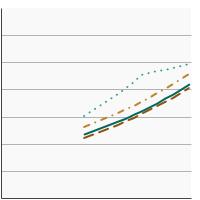

All Races/Ethnicities 
40.2 36.2 - 44.1 Non-Hispanic White 
39.1 35.4 - 42.9 Non-Hispanic Black 
51.5 45.9 - 57.1 Hispanic 
43.7 36.9 - 50.6 The 2021 to 2023 data point is from the NHANES August 2021-August 2023 data cycle. Males by Race/Ethnicity
Percentage of males aged 20 years and older with obesity by race/ethnicity, 1971-2023 Overview Graph Detailed Trend Graphs Most Recent Estimates (2021 to 2023) Percent of adults 95% Confidence Interval 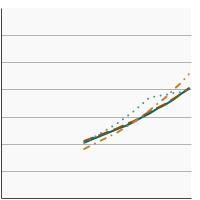

All Races/Ethnicities 
39.3 35.3 - 43.2 Non-Hispanic White 
38.2 34.4 - 42.0 Non-Hispanic Black 
47.0 37.7 - 56.2 Hispanic 
43.4 37.7 - 49.1 The 2021 to 2023 data point is from the NHANES August 2021-August 2023 data cycle. Females by Race/Ethnicity
Percentage of females aged 20 years and older with obesity by race/ethnicity, 1971-2023 Overview Graph Detailed Trend Graphs Most Recent Estimates (2021 to 2023) Percent of adults 95% Confidence Interval 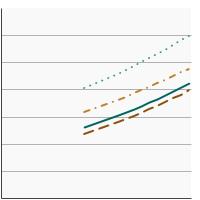

All Races/Ethnicities 
41.0 36.3 - 45.7 Non-Hispanic White 
40.1 35.8 - 44.4 Non-Hispanic Black 
55.1 48.3 - 62.0 Hispanic 
43.7 35.0 - 52.4 The 2021 to 2023 data point is from the NHANES August 2021-August 2023 data cycle. By Poverty Income Level
Percentage of adults aged 20 years and older with obesity by poverty status, 1971-2023 Overview Graph Detailed Trend Graphs Most Recent Estimates (2021 to 2023) Percent of adults 95% Confidence Interval 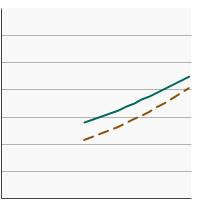

< 200% of the federal poverty level 
44.1 41.7 - 46.6 >= 200% of the federal poverty level 
38.1 33.1 - 43.1 The 2021 to 2023 data point is from the NHANES August 2021-August 2023 data cycle. By Education Level
Percentage of adults aged 25 years and older with obesity by highest level of education obtained, 1971-2023 Overview Graph Detailed Trend Graphs Most Recent Estimates (2021 to 2023) Percent of adults 95% Confidence Interval 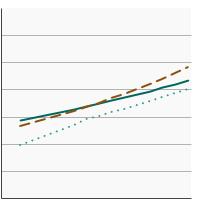

Less than High School 
44.9 37.4 - 52.5 High School 
48.4 43.5 - 53.3 Greater than High School 
39.1 34.5 - 43.6
Additional Information
- Obesity and Cancer. National Cancer Institute.
- ACS Guideline for Diet and Physical Activity. American Cancer Society.
- Body Weight and Cancer Risk. American Cancer Society.
- Obesity and Cancer. Centers for Disease Control and Prevention.
- Preventing Cancer. Centers for Disease Control and Prevention.
- Healthy Weight, Nutrition, and Physical Activity. Centers for Disease Control and Prevention.
- Obesity and Cancer. Centers for Disease Control and Prevention.
- Body Mass Index Table. National Heart, Lung, and Blood Institute.
- Chartbook on Healthy Living. Agency for Healthcare Research and Quality.
- Obesity Evidence-Based Programs Listing. National Cancer Institute.
- Obesity in Children and Adolescents: Screening (June 2017). U.S. Preventive Services Task Force.
- Weight Loss to Prevent Obesity-Related Morbidity and Mortality in Adults: Behavioral Interventions. U.S. Preventive Services Task Force.
- Clinical Practice Guideline for the Evaluation and Treatment of Children and Adolescents With Obesity. American Academy of Pediatrics.
- Diet, activity and cancer. World Cancer Research Fund and the American Institute for Cancer Research.
- Body fatness and weight gain. World Cancer Research Fund and American Institute for Cancer Research.
- Energy Balance and Body Fatness. World Cancer Research Fund and the American Institute for Cancer Research.
- Advancing Measurement for Childhood Obesity Workshop Series. National Collaborative on Childhood Obesity Research.
- Prevalence of Obesity and Severe Obesity Among Adults: United States, 2017–2018. Hales CM, Carroll MD, Fryar CD, Ogden CL. NCHS Data Brief, no 360. Hyattsville, MD: National Center for Health Statistics. 2020.
- Body Fatness and Cancer — Viewpoint of the IARC Working Group. Lauby-Secretan B, Scoccianti C, Loomis D, et al. N Engl J Med. 2016;375(8):794-798.
- Obesity and cancer risk: Emerging biological mechanisms and perspectives. Avgerinos KI, Spyrou N, Mantzoros CS, Dalamaga M. Metabolism. 2019; 92:121-135.
- Nutrition and physical activity cancer prevention guidelines, cancer risk, and mortality in the women’s health initiative. Thomson CA, McCullough ML, Wertheim BC, et al. Cancer Prev Res (Phila) 2014;1:42–53.
- 2018 Physical Activity Guidelines Advisory Committee Scientific Report. Part F. Chapter 5. Cardiometabolic Health and Prevention of Weight Gain. U.S. Department of Health and Human Services. F5-4 – F5-12.
- Obesity and Overweight. Centers for Disease Control and Prevention.
- Obesity Data and Statistics. Centers for Disease Control and Prevention.